Shipping is more than packaging and posting – it’s an opportunity to engage with customers.
Following on from our previous article ‘Everything you need to know about Ecommerce Payments’, let’s talk about shipping. Shipping is a major contributor to cart/basket abandonment, and it’s very easy to get wrong. But by following the advice in this article, we can convert more people, improve user experience and increase customer loyalty!
Presentation
How are you presenting your shipping to your customers? A simple radio button saying ‘Standard Shipping’, followed by the equally ambiguous ‘Express Shipping’?
Standard Shipping
Express Shipping
Think about this from a customer’s point of view, they’re unsure of when it might be delivered, what service is being used, and what the differences are between ‘standard’ and ‘express’ (apart from the implied extra speed).
When ordering online, shipping is when the customer starts thinking about actually receiving the goods. They want to make sure they aren’t inconvenienced by the delivery, whether that is knowing when it is being delivered (so that there is someone to receive it), knowing they’re delivery is safe and secure, and knowing that they’re getting a good price for it.
Presenting all of this information to customers is a task for designers. It is recommended to have a descriptive title for each shipping method that is meaningful to the customer.
3-5 day Royal Mail
1-2 day Royal Mail (insured)
The above is a lot nicer for customers than our previous example, it gives the customer some key information that is pertinent to them. What can also be useful is having a ‘more details’ popup, hover or box for each option, that only displays when the user requires it. This can give a bit more detail about each option, and why it is worth paying for the more expensive options.
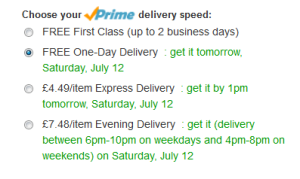
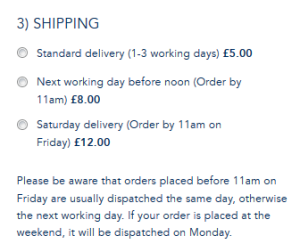
Delivery Info Box
This is a simple addition to any checkout. A text box that customers can fill in with more information about their delivery. Having this box may seem like it requires a bit more admin effort, but it also avoids customers calling or emailing in delivery requests after placing an order, or worst case not placing the order because they don’t feel confident that it will be delivered.
Shipping Cost
This is a tricky topic. It completely depends on your industry to what the ‘standard’ shipping rates are. For example a B2B company specialising in large scale products on pallets will have different shipping matrix calculation compared to a fashion clothing company.
However, there are some simple things to keep in mind when you’re creating your shipping pricing, which apply to everyone, no matter what industry you are in.
Be honest – Don’t overcharge
By all means make money on shipping, but don’t use it as a way of inflating your product profitability. If you undercut your competition on product cost, only to bump the cost up drastically with shipping, it is a recipe for losing customers and getting a bad reputation.
80/20 rule
It is tempting for businesses to over-complicate their shipping rates in an effort to make sure they never lose on shipping. In fact it is much better for you to have simple shipping rates that are easy to understand so that customers don’t just see what is perceived as a ‘random’ number.
The general rule is that you cover your cost or make money on 80% of your orders, and what you make will cover what you possibly lose on the 20%. You want to avoid charging more to the 80% of your orders, ‘just in case’ of the 20% orders. That being said you would need to work out where that value lies for your business.
Offshore and International
In the UK, we have Mainland UK delivery costs, and Offshore, Highlands and Islands costs. The good thing is that most of these customers expect to be charged more, however, like most customers they don’t like being reminded of it. If your competition is not charging extra for these regions, look at the cost implications of including these in your 80/20 rule.
Show only applicable options
This sounds simple, but there are plenty of sites that list international next to UK Mainland deliveries and expect customers to make the right choice. Whether by accident or trying to ‘cut corners’, international customers will select a non-international option and you will either spend time chasing them for the extra value, or have to foot the bill yourself to keep the customer ‘happy’.
Free Shipping
This is very dependent on your industry, however it is becoming more and more prominent within the fashion, clothing, media and electronics markets which are the most established ecommerce industries. Customers are being trained to ‘expect’ free shipping.
Unless you are selling digital/virtual products that can be downloaded or emailed, high-end services or premium products where delivery is included, then free shipping should be based on two things, either a premium subscription (Amazon Prime) or the total amount that the customer is spending in that transaction. The later of these is the most typical, and is usually presented as ‘Spend £100 and get Free Shipping’.
There is a simple calculation to work out where your free shipping band should be:
Average Order Value * 1.15 = Free Shipping threshold
It is worth rounding this number to a ‘nice’ number in whatever format you use on your site.
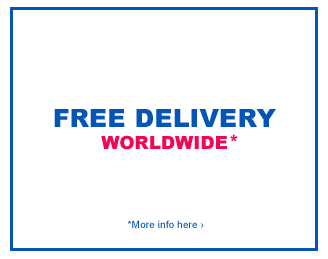
This encourages customers that are around your average order value (which should be most as it is an average) to spend ~15% more to get the free shipping. It’s always worth tracking this to see if it is worth increasing the threshold again, or possibly look at reducing it depending on conversion rates.
A little bonus, try putting ‘We’ll pay your shipping’ instead of ‘Free Shipping’. This has been A-B tested to improve conversion rates, and some customers even thanked the store owners!
Shipping Options
We’ve already discussed a couple of different options for shipping, but it’s important to know when you have too many. This will vary considerably for each business, industry and country, but you can easily make a judgement call when creating your shipping matrix. If it looks like someone might have too many choices, then reduce them down to key differentiators.
An example of this is Royal Mail Parcel Shipping:
Royal Mail Same day
Royal Mail Special Delivery Guaranteed
Royal Mail Signed for 1st Class
Royal Mail Signed for 2nd Class
1st Class Mail
2nd Class Mail
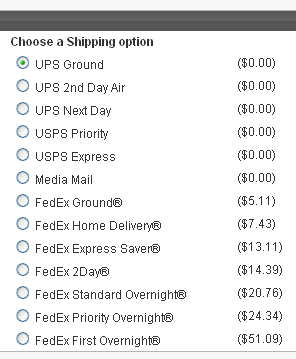
There are too many options here… It’s important to reduce them down to just the key ones that are likely to work for your customers. Hopefully, you can reduce it to, two or three options which covers the different price boundaries.
You can do the same for international, and any other special cases like Highlands and Islands, making sure that your website only shows the options that are applicable to the current customer.
Finally, provide a ‘catch all’ option. This could be something that is displayed when no other options are available, due to the size of the order, or the location it is going to. The simplest option is to put a message requesting the customer to call to arrange delivery. A more ‘customer friendly’ option is to give the customer a link to request a ‘call back’ at their convenience. Another ‘catch all’ is allowing the customer to ‘pick up in store’, this is really simple to arrange if you have a single warehouse or location, and can work really well for repeat customers in the local area.
Tracking Number
If a customer selects and pays for a tracked service, then they expect a tracking number to be provided. That number might not exist until the product has been picked and packed, but as soon as it is available the customer should be notified. Magento and most other ecommerce systems have the option of including this when processing an order, and will automatically trigger an email to the customer including it.
Some postal services, for example Yodal, provide email and SMS notifications to customers regarding the progress of their order, which is a great customer experience. All you need to do is fill in the customers email or mobile number, and they get maps and ‘live’ tracking of their delivery, with little effort from you.
Packaging
Once the product arrives, make sure that your User Experience continues to be as good as it was on the website.
There are some basics, like making sure the order is well packaged and protected. But the companies and brands that make the best (and lasting) impression go the extra mile with their packing. Making the ‘unboxing’ an experience that they want to share.
The box or packaging shouldn’t be difficult to get into, and shouldn’t have to be destroyed to access the products. Customers are still very conscious about ‘returning in original condition’, so making it easy for them to preserve the packing is a nicer experience.
This could be as simple as custom bags and boxes, and unique packing materials. Or go all out and use luxury materials to package the items, and make the customer feel like they’re getting a gift (that they’ve bought themselves). Fancy Box is a great example of making the ‘unpacking’ an event for its customers.
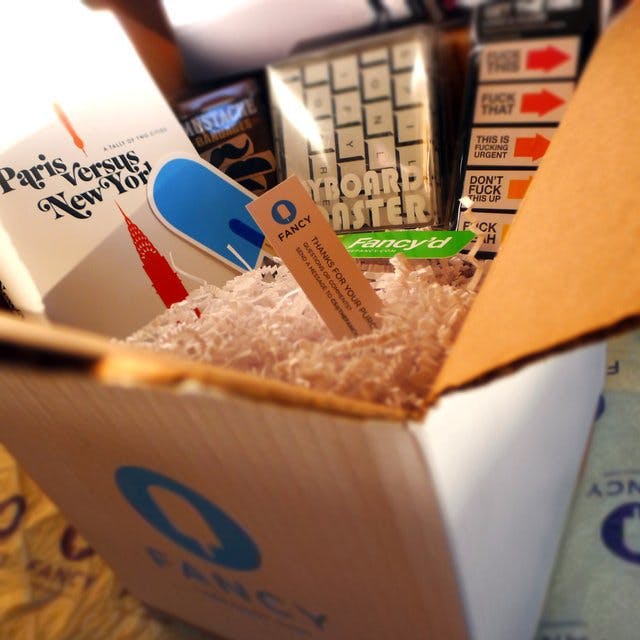
Perceived added value
Through the package, the customers now have the opportunity to continue the customer experience. Adding something ‘extra’ for the customer is a great way of encouraging them to shop again, engage with your company in social media, increasing their brand loyalty.
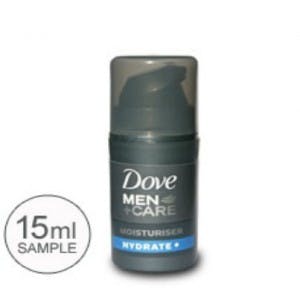
An example of this is Boots the pharmacy, when ordering from them online, they will include samples of new and related products, encouraging customers to purchase the ‘full size’ products’. This has a secondary effects on the customer who:
Thinks they got a better deal (everyone likes free stuff)
Feels valued as a customer (differentiation from competitors)
Is more likely to remember this shopping experience as a good one (which leads to repeat orders)
Whether it is including a voucher for discount off the next order, free samples, or something completely unrelated, the inclusion must do two things:
Be of value to the customer – entertainment, monetary, or associative value
Evoke positive emotions in the customer and be directly or indirectly memorable
Documents and Promotion
Make sure that all documents (invoice, packing slip, leaflets) are continuing your online experience, and that they are applicable; not just advertising. This means that they are branded appropriately and clear in purpose.
This is another perfect opportunity to encourage customer to engage with the brand. The customer has received their order, they’ve been wowed by your delivery, packaging and the whole experience has been positive. To make the most of this:
Encourage customers to post about their order or product on social networks
o Most customers will have a mobile, tablet or computer somewhere close by, make it as easy as possible for them to like, and share your company with their friends.
Make sure that any support and help communities are clear
o If you’ve got a forum for your site, or a product range, encourage your customers to visit them.
Get them to sign up for more marketable material
o Offer competitions, newsletters and other benefits for people who sign up or like your pages
o This is great for customers who didn’t create an account, but checked out as a guest, so that you can capture their details and market to them to turn them into a repeat customer
Returns
Finally, returns. Nobody likes returns, customers don’t like having to send products back, and online businesses don’t like having to receive, restock and possibly refund customers. So how can we turn what is a ‘bad customer experience’ into a potentially ‘good customer experience’.
Firstly, make sure that you have a solid returns procedure, which is documented on your website (this in itself can make or break an online sale), also have a summary of the return on the invoice, so that it is easy to find if the customer needs it. The policy should be fair to both customers and the business.
Next make the return as easy as possible. Include a simple form for the customer (possibly a tear off part of their invoice, or online) to fill out with all the details you would require to complete the return. Have the return address clearly printed and available.
Try and encourage customers to contact you before they return the item. There is still potential for you to help the customer, maybe they’re having trouble with the item that can be solved with some training, maybe they require a different item and there is an opportunity to sell something new to them, or maybe they’re just not happy with the product and you can get some honest feedback on how to avoid a similar return in the future. Great ecommerce customer service is vital!
When the product is being returned, make sure that you are communicating with the client, letting them know when the product is received, when new products are on the way, or when your process a refund. If you communicate the whole route, there is very little chance of a miss communication, or a bad customer service experience which might ‘rub salt in the wounds’.
Summary
We’ve talked about almost every aspect of shipping, and how it could apply to your online store. It is a huge part of the customer experience, and is sometimes overlooked. Make sure that you are using any opportunity to give customers a unique and memorable experience. Happy Shipping!



